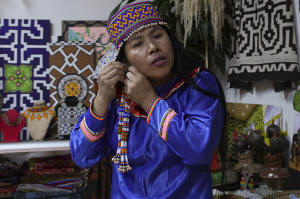These Peruvian women left the Amazon, but their homeland still inspires
their songs and crafts
 Send a link to a friend
Send a link to a friend
 [November 25, 2024]
By MARÍA TERESA HERNÁNDEZ [November 25, 2024]
By MARÍA TERESA HERNÁNDEZ
LIMA, Peru (AP) — Sadith Silvano’s crafts are born from ancient songs.
Brush in hand, eyes on the cloth, the Peruvian woman paints as she
sings. And through her voice, her ancestors speak.
“When we paint, we listen to the inspiration that comes from the music
and connect to nature, to our elders,” said Silvano, 36, from her home
and workshop in Lima, Peru, where she moved two decades ago from Paoyhan,
a Shipibo-Konibo Indigenous community nestled in the Amazon.
“These pieces are sacred,” she added. “We bless our work with the energy
of our songs.”
According to official figures, close to 33,000 Shipibo-Konibo people
inhabit Peru.
Settled in the surroundings of the Uyacali river, many relocated to
urban areas like Cantagallo, the Lima neighborhood where Silvano lives.
Handpainted textiles like the ones she crafts have slowly gained
recognition. Known as “kené,” they were declared part of the “Cultural
Heritage of the Nation” by the Peruvian government in 2008.
Each kené is unique, Shipibo craftswomen say. Every pattern speaks of a
woman’s community, her worldview and beliefs.
“Every design tells a story,” said Silvano, dressed in traditional
clothing, her head crowned by a beaded garment. “It is a way in which a
Shipibo woman distinguishes herself.”
Her craft is transmitted from one generation to another. As wisdom is
rooted in nature, the knowledge bequeathed by the elders connects
younger generations to their land.
Paoyhan, where Silvano was born, is a flight and a 12-hour boat trip
away from Lima.

In her hometown, locals rarely speak languages other than Shipibo. Doors
and windows have no locks and people eat from Mother Nature.
Adela Sampayo, a 48-year-old healer who was born in Masisea, not too far
from Paoyhan, moved to Cantagallo in the year 2000, but says that all
her skills come from the Amazon.
“Since I was a little girl, my mom treated me with traditional
medicine,” said Sampayo, seated in the lotus position inside the home
where she provides ayahuasca and other remedies for those ailing with a
wounded body or soul.
“She gave me plants to become stronger, to avoid getting sick, to be
courageous,” said Sampayo. “That’s how the energy of the plants started
growing inside me.”
She, too, conveys her worldview through her textiles. Though she does
not paint, she embroiders, and each thread tells a tale from home.
“Each plant has a spirit,” said the healer, pointing to the leaves
embroidered in the cloth. “And medicinal plants come from God.”
The plants painted by Silvano also bear meaning. One of them represents
pure love. Another symbolizes a wise man. One more, a serpent.
“The anaconda is special for us,” Silvano said. “It’s our protector,
like a god that cares for us and provides food and water.”
In ancient times, she said, her people believed that the sun was their
father and the anacondas were their guardians. Colonization brought a
new religion — Catholicism — and their Indigenous worldview was diluted.
“Nowadays we have different religions,” Silvano said. “Catholic,
evangelical, but we respect our other beliefs too.”
For many years, after her father took her to Lima hoping for a better
future, she yearned for her mountains, her clear sky and her time alone
in the jungle. Life in Paoyhan was not precisely easy, but from a young
age she learned how to stay strong.

[to top of second column]
|

Sadith Silvano, from Paoyhan, a Shipibo-Konibo Indigenous community
in the Amazon, puts on an earring at her home and workshop where she
hand-paints textiles in Lima, Peru, Saturday, Oct. 19, 2024. “When
we paint, we listen to the inspiration that comes from the music and
connect to nature, to our elders,” said Silvano. (AP Photo/Guadalupe
Pardo)
 Back in the 1990s, Amazonian
communities were affected by violence from the Shining Path
insurgency and illegal logging. Poverty and sexism were also common,
which is why many Shibipo women taught themselves how to navigate
their anguish through the heartfelt music they sing.
“When we encounter difficult times, we overcome them with our
therapy: designing, painting, singing,” Silvano said. “We have a
song that is melodic and heals our soul, and another one that is
inspiring and brings us joy.”
Few Shipibo girls are encouraged to study or make a living of their
own, Silvano said. Instead, they are taught to wait for a husband.
And once married, to endure any abuse, cheating or discomfort they
may encounter.
“Even though we suffer, people tell us: Take it, he’s the father of
your children. Take it, he is your husband,” Silvano said. “But deep
inside, we are wounded. So what do we do? We sing.”
The lesson is taught from mothers to daughters: If you hurt at home,
grab your cloth, your brush and leave. Go far away, alone, and sit.
Connect with your kené and paint. And while you paint, sing.
“That’s our healing,” Silvano said. “Through our songs, our kenés,
we are free.”
In the workshop where she now works and raises her two children on
her own, Delia Pizarro crafts jewelry. She, too, sings as she
creates birds out of colorful beads.
“I didn’t use to sing,” Pizarro said. “I was very submissive and I
didn’t like to speak, but Olin, Sadith’s sister, told me, ‘You can
do this.’ So now I’m a single mother, but I can go wherever I want.
I know how to defend myself and fight. I feel valued.”
The figures in the products they craft for sale are varied. Aside
from anacondas, they like to depict jaguars, which represent women,
and herons, which were treasured by the elders.
A Shipibo textile can take up to a month and a half to be completed.
Materials required to craft it — the cloth, the natural pigments —
are brought from the Amazon.
The black color used by Silvano is extracted from a bark tree that
grows in Paoyhan. The cloth is made of local cotton. The mud used to
set the colors comes from the Uyacali river.

“I like it when a foreigner comes and leaves with something from my
community,” said Silvano, touching one of her freshly painted
textiles to bless it for a quick sale.
She said that her people’s crafts were barely known when she and her
father first arrived in Lima 20 years ago. But in her view, things
have now changed.
In Cantagallo, where around 500 Shipibo families have settled, many
make a living selling their crafts.
“My art has empowered me and is my loyal companion,” Silvano said.
“Thanks to my mother, my grandmother and my sisters, I have a
knowledge that has allowed me to open doors.”
“Here’s the energy of our children, our ancestral world and our
community,” she added, her textiles still between her hands. “Here’s
the inspiration from our songs.”
____
Associated Press religion coverage receives support through the AP’s
collaboration with The Conversation US, with funding from Lilly
Endowment Inc. The AP is solely responsible for this content.
All contents © copyright 2024 Associated Press. All rights reserved |